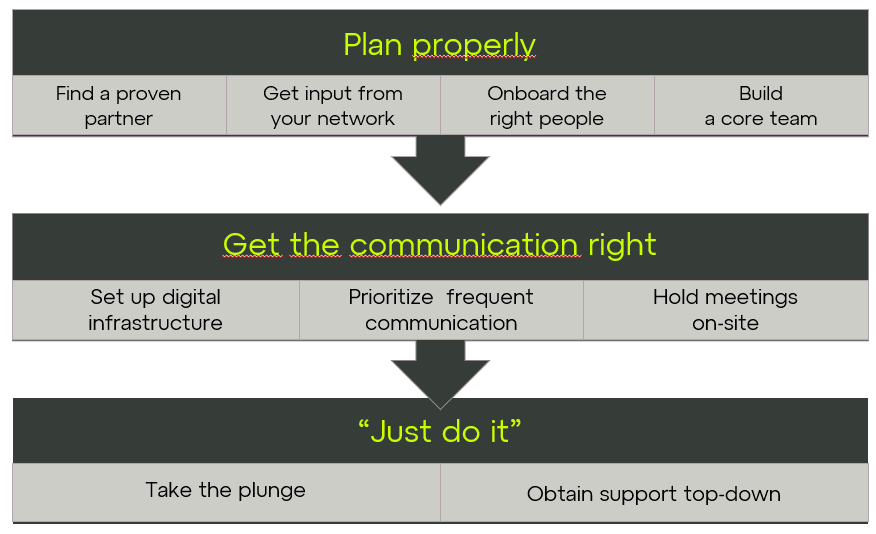
t’s not rocket science to succeed with nearshoring, but there are a few things you need to consider if you want to maximize the value of your new setup.
This guide gives our top tips to ensure you get off to the best start.
For many companies, the decision to go nearshore is not an easy one. It’s a decision that requires a great deal of consideration – we know that because several of our current clients were also reluctant to go nearshore at first.
But if you are mindful of the pitfalls mentioned in this article, you can also maximize the potential of nearshoring.
We summarize all our tips in three main stages, elaborate on each one in further detail, and ultimately present you with a checklist at the end of the article.
The three stages we will discuss are:
Closing a deal for a nearshore operation can involve many stages and phases in planning and setting it up correctly.

Find a supplier with the experience and local contacts
Use experienced suppliers with local contacts in the establishment phase. Insight into the local market, the consultants and how to deal with the nuts-and-bolts logistics is a considerable advantage.
Furthermore, a proven supplier will have a strong interest in ensuring your nearshoring operation is successful. At the same time, they can handle the entire setup for you, saving you much time and minimizing costs in the start-up phase.
This will allow you to stay focused on the things that add value to your business.
Take advantage of networks, both your own and that of your supplier. Get in touch with companies that have been through the same exercise your company is doing.
Listen and learn; adapt their lessons to your situation.
Many companies come to Poland and get enthusiastic about the volume of talented resources and the expertise of the individual consultants.
Sometimes, they end up onboarding overqualified consultants for their projects, which ultimately means they can’t offer the consultant professional challenges.
To retain a motivated, high-performance team, ensuring a good match between the projects and the consultant’s skill set is crucial. With that in mind, it’s essential to select highly skilled consultants who can help you get off to a good start and create momentum in the project.
Make sure that the first tasks are ready and waiting so the consultant can hit the ground running, instead of waiting for the developers or documentation before they can get started on the project.
Start by building a core team that can later become the foundation if you decide to scale up.
These initiatives will allow you to transfer the company’s values to them, so they absorb the company’s culture entirely. In this way, your company creates culture bearers who will help shape new consultants in the future.
Start by building a core team that can later become the foundation if you decide to scale up.
Make sure that the first tasks are ready and waiting so the consultant can hit the ground running, instead of waiting for the developers or documentation before they can get started on the project.

Ensure the company has a good digital infrastructure supporting collaboration across national borders. Tools that can connect employees and improve their communication are essential. For example, video conferencing technologies make collaborating and working on specific tasks easier.
Schedule frequent meetings. It feels easy and natural to call someone or send a mail if you have a question. But we don’t always get around to it – or sometimes our colleague isn’t available. When we schedule a meeting, we’re more likely to prioritize the conversation – or at least we should be.
We recommend a two-week introductory program in your home country that allows your company to prepare the consultants for their future assignments and get to know your culture first-hand. But in addition to this, make sure you schedule visits regularly in both locations – meeting in person is essential.
If your company has decided to try nearshoring, then it's important to take the plunge and get going.

For a nearshoring operation to thrive over a more extended period, it must have the support of management.
There needs to be a long-term commitment to the project to succeed. And if your nearshoring operation is to be scaled up to benefit your organization on a broader scale, you need to ensure it’s anchored in your strategy.
This will enable you to take more long-term decisions on how to get the most out of nearshoring to reach your organization’s strategic goals.
If your company has decided to try nearshoring, it’s important to take the plunge and get going.
Some things can be planned in advance; in other cases, it’s learning by doing. In both cases, the experiences you gain will be valuable for your organization.
In addition, make a point of meeting some consultants, experiencing the work culture first-hand and seeing the work environment. Working close to your consultants is an eye-opener for many companies.